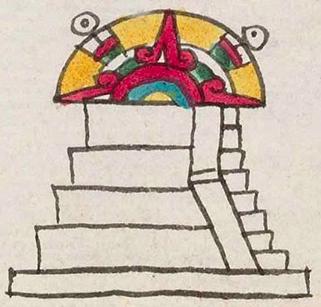Teopantlan (Mdz42r)
This compound glyph for the place name Teopantlan has two principal components, the sign for teotl (divine or sacred force or forces) and the sign for teopan or teopantli (temple), a stepped pyramid. The teotl sign is a half sun, with multiple colors, points, and concentric circles. It sits atop the stepped pyramid, which is left white/neutral. The locative suffix -tlan is not shown visually, unless it is implied in the presence of a building, signifying a place.
Stephanie Wood
The phonetic value "teo" comes from both teotl) and the first part of teopantli. The teotl serves as what Whittaker calls a "semantic indicator," with the first "teo" clarifying that this is a teopan and not another type of building, such as a tetelli. It would not, however, clarify that this is not a teocalli. Still, the teocalli glyph shows a calli on top of the teopantli. [See below, right.]
Like the tecpan (governing palace), which typically lacks an absolutive, the teopantli was often just called teopan.
Stephanie Wood
teopantlan. puo/
Teopantlan, pueblo
Stephanie Wood
c. 1541, but by 1553 at the latest
Stephanie Wood
palaces, pyramids, solar disks, suns, nombres de lugares

teo(tl), divine force(s), https://nahuatl.wired-humanities.org/content/teotl
teopan(tli), temple or church, https://nahuatl.wired-humanities.org/content/teopantli
teopan, temple or church, https://nahuatl.wired-humanities.org/teopan
--tlan (locative suffix), https://nahuatl.wired-humanities.org/content/tlan
"By the Temple" (Whittaker, 2021, 79)
TEOTEOPAN
Codex Mendoza, folio 42 recto, https://digital.bodleian.ox.ac.uk/objects/2fea788e-2aa2-4f08-b6d9-648c00..., image 94 of 188.
The Bodleian Libraries, University of Oxford, hold the original manuscript, the MS. Arch. Selden. A. 1. This image is published here under the UK Creative Commons, “Attribution-NonCommercial-ShareAlike 3.0 License” (CC-BY-NC-SA 3.0).



